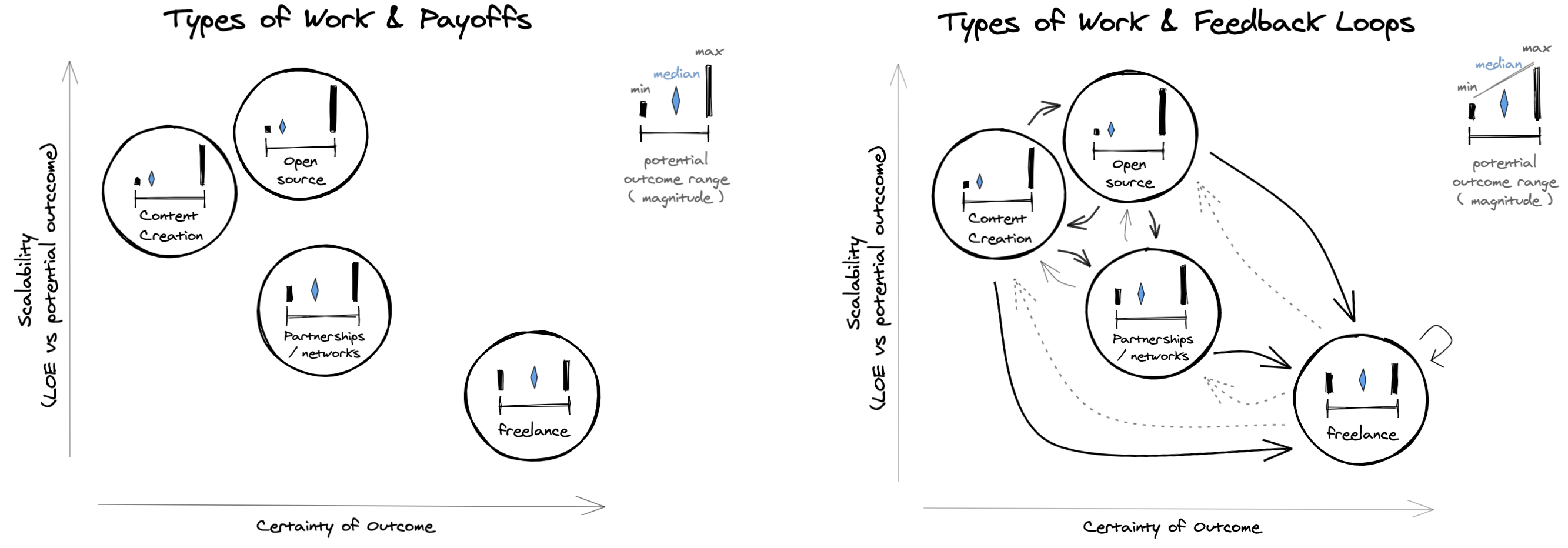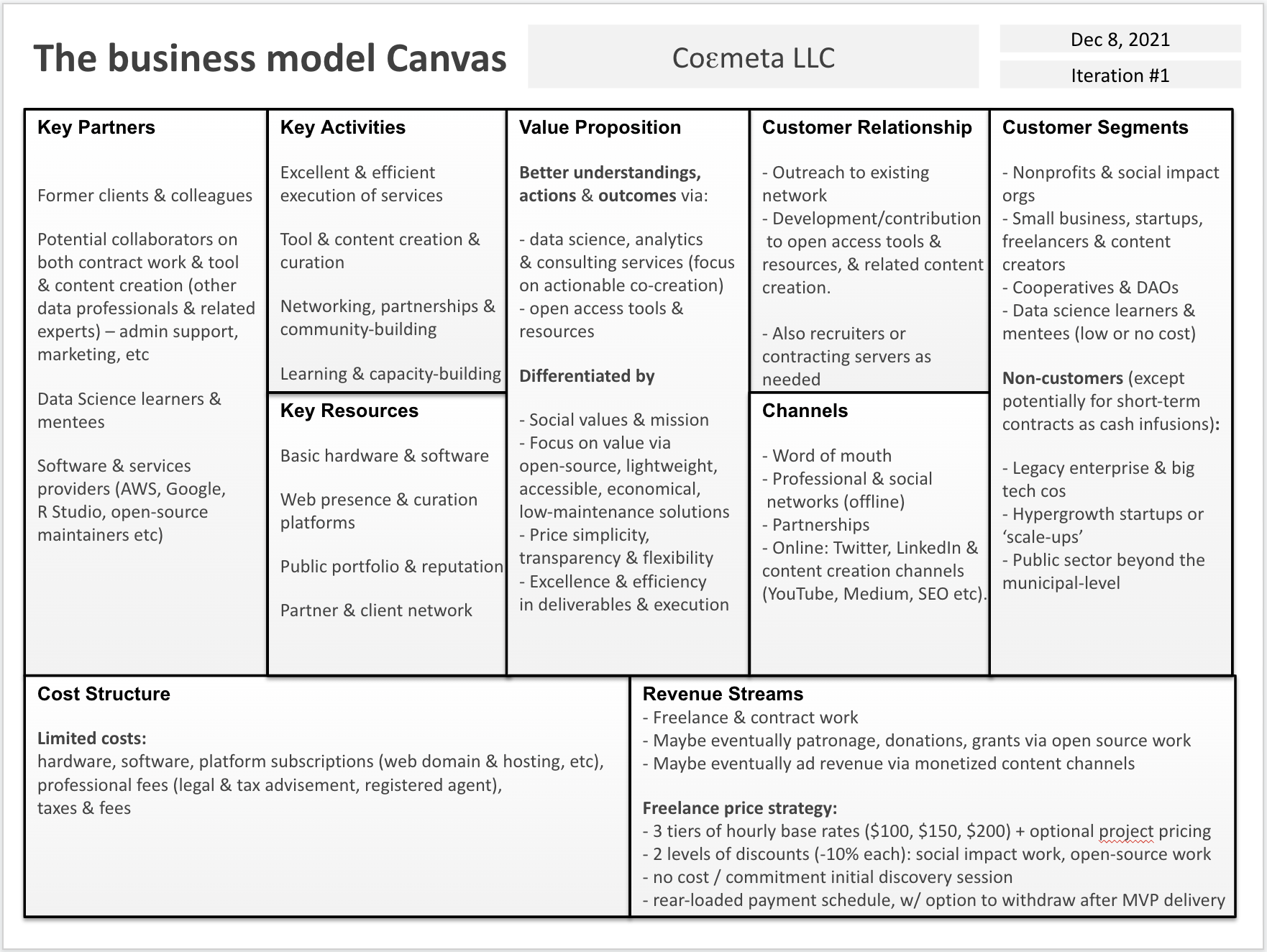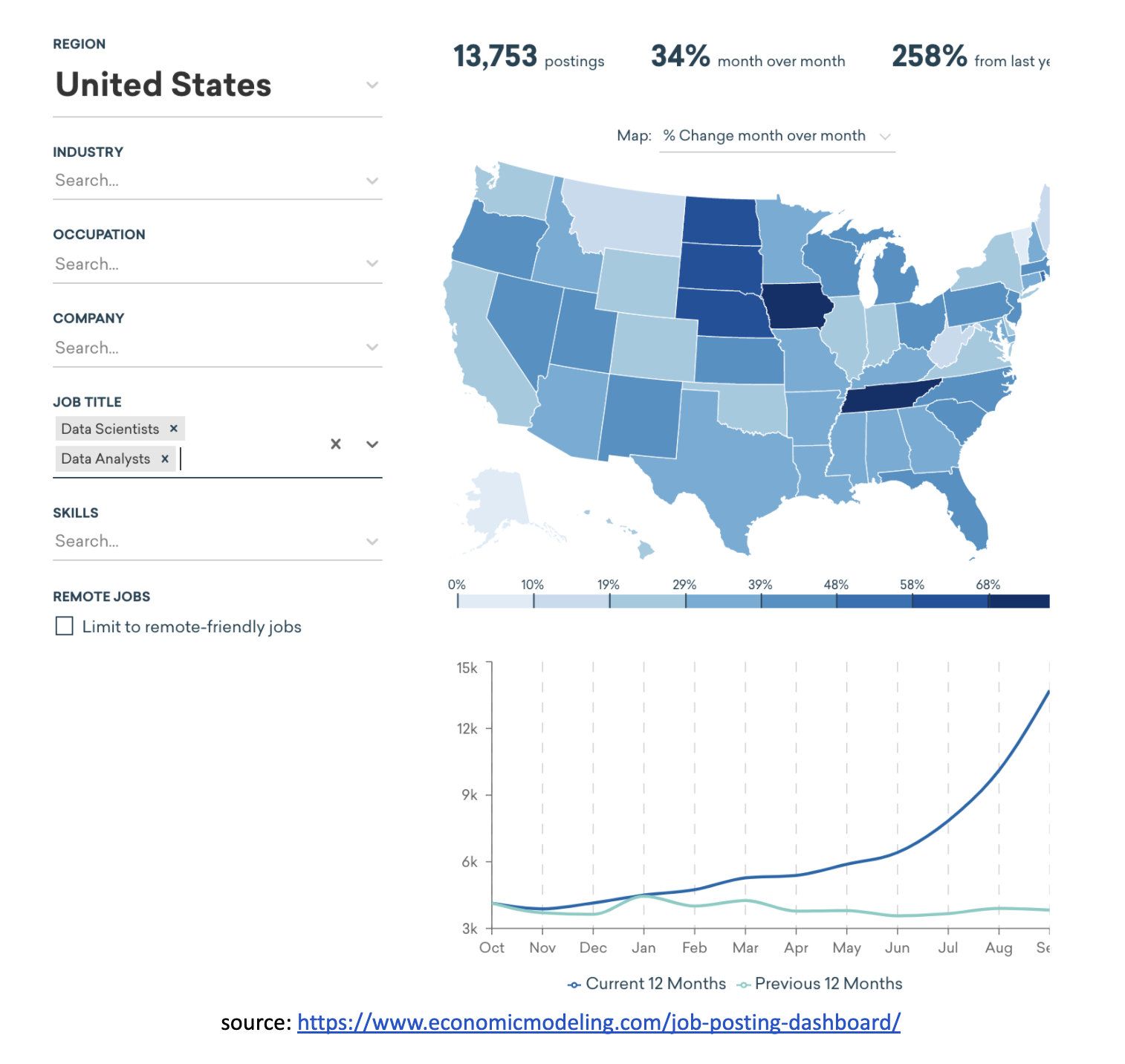This is the first of many intended Public Work Log entries for Coεmeta, a Public Benefit company providing data & sensemaking services with positive externalities. It's intended as a window into our journey & playbook as it develops, in the spirit of working in public, contributing to knowledge commons, "finding the others" & leaving a trail + some resources for those that follow. I hope it inspires more folks to follow a similarly rewarding path & find similar (if modest & provisional) success. Feel free to reach out at any time, I'm happy to help however I can!
- Daniel McNichol, founder & Chief Data Scientist
This post is mirrored at: Github (primary source & version control) & Roam (navigable outline format), & excerpted at Medium & LinkedIn
...comments, forks & pull requests are welcome!
- 📜 Prologue: backstory & motivations
- 🗺 Strategic Frameworks: sensemaking, planning & evaluation
- 🔭 Mission & Vision statements
- 🏛 Strategic Pillars (types of work)
- 📦 Strategic Pillar 2x2s (++): Certainty vs Scalability (+ feedback loops & interdependencies)
- 📝 Business Plan & Business Model Canvas
- 🧠 Logic Model
- 🗺 Wardley Maps
- 🧮 OKRs
- 📊 Metrics / KPIs / Dashboard
- 👥 Values-Based Social Design (to come)
- ⏳ Timeline
- ꩜ Coda: eval & checkout
💡 click headings to expand sections, then the Contents links above will work
Coεmeta is my attempt at an infinite game. The goal of infinite games is not to win, but to keep playing.
I consider this my metagame (as opposed to endgame):
a more balanced, integrated, enriching & impactful life in greater community
To pursue this metagame indefinitely (aka "infinitely"), I needed to reclaim some agency & autonomy in my work. So Coεmeta is also currently a Pennsylvania Public Benefit LLC, serving as a vehicle for more traditional freelance & consulting work, as well as broader public-benefit oriented activities.
(My longer-term vision for Coεmeta as a formal entity is something more like a worker-owned cooperative or DAO with shared collective ownership, or at least part of a federated network of mutual aid & partnerships with other "self-sovereign" ᵋ groups or entities. This is part of the "in greater community" aspect of the metagame, but more on that later.)
So Coεmeta is not exactly a traditional 'venture' or typical small business or startup etc, but assumes some of those trappings for now. The ⏳ Timeline below recaps more of the motivations & considerations underlying all of this, & the 🗺 Frameworks section describes some of the strategic planning & wayfinding models I've used so far.
As elaborated below, public work & contributing to knowledge commons are core parts of the overall metagame strategy & ethos. So this post is part of that: figuring it out as I go, learning while doing, in public. I hope to establish a template & cadence for these things.
ᵋ NB: I'm generally skeptical of this terminology & its associations with neoliberal / libertarian fantasies of fully atomized "sovereign individuals", but "independent" isn't quite adequate either.
As a decision science practitioner & general strategy nerd, I've seen how the right framework can simplify, clarify & streamline the task of making sense of information & (potential) actions — as long as we don't mistake the map for the territory ᵋ. So I've made ample use of various models & frameworks in the planning & execution of Coεmeta to date. This is a short list of the most relevant & cogent.
Note that these are snapshots, in various states of refinement & iteration (proper version-controlled repositories are forthcoming [now here!], along with more thorough evaluations — this is a more narrative account). Further, the frameworks are essentially just differently shaped containers filled with mostly the same content, but the varying shapes help emphasize (& scrutinize) different dimensions of the information & underlying intent, which is in fact much of the value of such frameworks.
ᵋ ...a few more obligatory caveats & cautionary aphorisms regarding models & planning:
- "Plans are worthless, but planning is priceless"
- "Everyone has a plan until they get punched in the mouth"
- (Optionality & OODA loops are often better than plans — see also Emergent Strategy)
- "All models are wrong, but some are useful"
- See generally: complexity science & chaos theory, e.g. Robert May (1976)
- In fact the epsilon ("ε") in Coεmeta is meant as a reminder of the 'error margin' in any model, estimate or probabilistic assessment. (see further details on this etymology in the timeline below)
Mission & Vision statements are notoriously wonky & vacuous standard MBA-ware. But they can be useful exercises in distillation of values & intention, & sometimes produce helpful mantras for orientation & alignment. Sort of qualitative "north stars".
The rule of thumb I use: Vision describes the big picture outcome you want to realize, Mission describes how you'll do it.
It's hard to be simultaneously concise, substantive & clear, so lapsing into banal tropes & cliches is a common pitfall — which I haven't managed to entirely avoid. Familiar shorthands are useful compressions! But also risk total semantic satiation & meaninglessness. So I haven't yet found a satisfying alternative to the facile "better world / place / communities" shibboleths:
Coεmeta Vision (usually some permutation of):
Better places & relations through better information & finding truth together
Coεmeta Mission:
Create data & sensemaking tools & services with positive externalities: supporting commons, public goods, circular & solidarity economies & prosocial change.
As mentioned, I'm not fully satisfied with these, due to the cliches as well as some niche jargon (sensemaking, positive externalities, etc). But I think the general vibe is right, & try to clarify the jargon via context, elaboration & reference links. I also wanted to include verbs in the vision as well as nouns, to emphasize the importance of process beyond any static outcome or state. Will continue to workshop, like everything else.
And of course, there is my broader metagame vision, which applies more to me personally to than to Coεmeta itself, though Coεmeta is a integral strategic play in the metagame mission (for myself & others).
This is not so much a framework as a simple taxonomy that underlies the overarching vision & strategy for Coεmeta, specifically regarding the types of "work" we'll do. These might be thought of as "business units", "verticals", or "functional areas" in more traditional corporate or functional strategy.
The pillars are:
- Freelance / contract work
- Traditional hourly rate or project-based work, consulting etc.
- Content creation
- Part of Working In Public as well as building a public presence, portfolio & demonstration of capabilities, etc. All with an orientation towards positive externalities, public goods & contribution to knowledge commons, etc.
- Open source toolmaking
- Creating open source & open access tools & resources. Related to & overlapping with Content creation, but with a more technical & functional focus, vs informational & didactic resources. Again oriented towards public goods, etc.
- Relations & community-building
- Building networks of mutual support, partnership & exchange, etc (e.g. mutual aid & microsolidarity).
- (Could be more conventionally or cynically construed as: professional networking, growth hacking, clout chasing, social climbing, etc. But the intent is a more wholesome, positive-sum, good-vibes approach.)
It was obvious & important to me to enumerate these as I initially conceived of the core activities of Coεmeta, & they recur throughout the other frameworks for obvious reasons. Once enumerated, they provoke an obvious followup question: how they relate to each other via interconnections, interdependencies & feedback loops, which subsequent frameworks explore below.
Of course we can't avoid some sort of 2x2, the bullshit peddler management consultant's favorite WMD (weapon of mass defrauding). However, I feel these mutant versions are sufficiently novel & abstruse to avoid the most pathological forms of consultant-itus. And anyway, all such frameworks operate similarly via some sort of complexity- or dimensionality-reduction (e.g. of the true territory to an approximate map). 2x2's just tend to be among the most egregiously reductive.
Nevertheless, I wanted to visualize a few pertinent dimensions of these pillars & the relations between them. To concretize the hazy notions I had floating around my head. So I sketched out these two versions as a first approximation:
There's a lot going on in these, both visually & conceptually, but suffice to say: the right-side is identical to the left-side, with additional arrows indicating potential feedback loops (& their relative strengths, via line type & weight). Just wanted to preserve a cleaner / simpler version on the left, without the Feedback Loop dimension.
The dimensions I wanted to capture & convey:
- Certainty of Outcome (x-axis): for some fixed amount effort or 'input', how confident can we be in the outcome or 'payoff'
- Scalability (LOE vs potential outcome) (y-axis): how high is the 'payoff' ceiling for some fixed amount of effort / input
- Potential Outcome Range (inner circles, see legends): a sort of confidence interval or distribution around the range of expected outcomes or payoffs. (I'm most dissatisfied with the clarity & interpretability of this element, but it sufficed for a first pass, even if only I 'get it')
- Feedback Loops & Interdependencies (arrows, right-side): Fairly self-explanatory, how outputs & outcomes from one pillar / node might impact or contribute to another, & what virtuous cycles (flywheel!), efficiency-gains & tactics this might imply
- (as is probably clear, these dimensions are not entirely orthogonal / independent from each other, but imo worth distinguishing to be able to reason about their relative potentials & strategic implications)
Per usual, I'm not entirely satisfied with these, but they served their immediate purpose: to clarify fuzzy notions in my head, via marginally-less-fuzzy lines on a surface. The result is fairly dense with info, assumptions & implications, but if you stare & squint long enough, some observations emerge: (click to expand)
-
Freelance work is depicted as high-certainty & low-scalability (`x` vs `y` axis), with a narrow outcome range (inner circle viz) & several interdependencies (arrows). Let's unpack that:
- High-certainty: Due to the contractual nature of this work, outcomes & payoffs are pre-specified to some degree, resulting in relatively high certainty. NB: non-monetary outcomes (e.g. social impacts) are obviously less certain, & this does not account for the inherent uncertainty in securing freelance work, but rather applies to the work itself, if & when secured.
- Low-scalability: Again, due to the contractual nature, it's unlikely that we'll agree to a fixed rate & scope of work & then end up making 10x that, without an additional ~10x effort. Thus the marginal gains per unit of work are fairly constrained.
- Narrow outcome range: Again related to the pre-specified quid pro quo nature of contract work, the expected outcome range is fairly bounded by the rates I'm willing to accept vs the rates clients are willing to pay, & most often will fall somewhere in the middle. Of course it's always possible that some extreme outlier event occurs, or an enormous non-monetary impact is achieved, but we're working in the realm of averages outcomes & expected value here.
- Interdependencies: The theory depicted here is that the other 3 pillars all might contribute fairly strongly to freelance work (e.g. by generating interest, growing network connections & referrals, etc). But freelance work will only contribute weakly back to them (e.g. by open-sourcing work projects, generating ideas for content creation, & growing the network of contacts & partnerships). And a happy client is often a repeat client or referrer, so freelance work can lead to more of itself. These hypotheses, like everything else in these frameworks, will have to be tested in practice & adjusted accordingly. (science!)
-
By way of contrast: Content creation is depicted as low-certainty & highly-scalable, with a wide outcome range (skewed toward the low end) & again several interdependencies. I won't elaborate these in the same detail, but suffice to say:
- Any given piece of content is most likely to attract a very small audience, but could possibly go viral with practically unbounded upside for the same level of effort. This accounts for the first 3 dimensions.
- As far as interdependencies, it should be fairly self-evident that creating content might lead to creating technical implementations & vice versa, as well as attracting some audience, potential collaborators & clients.
- The same reasoning is applied to the other two pillars, so I won't belabor them here.
- I will just comment that this exercise helped to crystallize & confirm some of my assumptions, & convince me of an initial strategic focus on the more scalable pillars while I'd have some cushion & runway to experiment & roll the dice for a potential big payoff, or at least build some more scalable foundations & start seeding the ground / greasing the flywheel. (This strategy ended up getting a bit deferred, as described in the ⏳ Timeline section below).
Final notes on these mutant 2x2s:
- Each pillar of course has its own (sub)strategy & tactics, integrated w/ the macro strategy, which I'll publish at some point.
- Locations of pillars / nodes in the x-y plane should not be static, but could (or should) be moved (as part of strategy).
- Temporal aspects are not captured, but there is a temporal strategy implied (as mentioned above):
- initially invest in low-certainty / high-potential work, to seed flywheel dynamics
- partnerships as potential interim / intermediary accelerant / amplifier
- freelance as 'safety net' fallback of safer bets but lower potential
More standard MBA-ware, & I likely wouldn't have utilized these particular templates on my own. But I reached out to my local SBDC & SCORE organizations as part of my initial planning & research (both of which are free & have been enormously helpful & valuable in different ways — highly recommended!), & they suggested going thru these exercises to facilitate further consultation.
In both cases, I had already thought through & drafted most of the content in some form or another, so the exercise was essentially pouring the relevant info into these particular containers. And in both cases, it felt like a worthwhile exercise, especially distilling things down for the canvas one-pager.
Both of these were fairly early iterations, & my latest thinking & formulations are currently better reflected on the Coεmeta landing page (coemeta.xyz). But worth including for reference:
(I'll embed the Business Model Canvas one-pager below, but the Business Plan is much longer, so will just hyperlink.
And here are links to the original templates: Model Canvas, Business Plan)
These are mostly self-explanatory & but a few further comments: (click to expand)
- Despite being mostly redundant, it occurred to me for the first time during the canvas exercise that "excellence & efficiency" was core to my past career success & work ethic, & worth making an explicit part of Coεmeta's value proposition. This speaks to the value of revisiting these prompts from different angles via different frameworks & formats, etc.
- It's a bit unconventional to specify 'non-customer' segments in these things, but I firmly believe Michael Porter's axiom: "The essence of strategy is choosing what not to do", despite the rarity of this in practice (much like strategy itself). Of course, like anything else, this focus might change over time.
-
Some additional details from the business plan worth excerpting here:
-
Part of the thesis for Coεmeta, & why it might work, is how poorly orgs are currently served by data operations...
-
... & how demand continues to grow despite that fact (this also points to an eventual reckoning & bubble-burst)
-
Also relevant & somewhat glossed over here: I'm 'bootstrapping' Coεmeta, by self-funding initial expenses & giving myself some modest runway out of personal savings from my last 13 years of work. This is largely possible due to being relatively fortunate so far in life:
- socially privileged on axes of race & gender presentation etc
- able-bodied & in good health
- have no debt (went to college tuition-free because mom was a professor 💜 👑, inherited my grandfather's car after college & have only owned a bicycle since it stopped running, no mortgage & have always rented apartments, etc)
- am not raising a family etc, so have considerable flexibility in my own budget, to go "lean" personally as well as professionally
- did not grow up wealthy, no trust fund etc, but come from a supportive & financially-stable middle class family, which in America is more of a safety net than most can count on...
-
Related to the above, this excerpt re: financial projections & assumptions is relevant:
-
Logic Models are common, longstanding frameworks in project management & social impact work, & have recently gained traction in Product Management via "Outcomes-based planning".
As the name suggests, logic models ask us to specify the logical sequence of events or activities we expect to produce our desired outcome. This is often simply an instantiation of the underlying Theory of Change, & we might interpret this as the logic underlying how we expect to get from Mission -> Vision
In one of its simplest forms, this involves mapping Inputs -> Outputs -> Outcomes. Each of these terms is defined in a specific way in this context, & some models use additional or alternate concepts such as Resources, Activities, Impacts, etc.
I haven't formally articulated a Theory of Change yet, but it is implicit in the (very rough) initial Logic Model draft below. In addition to being a rough draft, the only visual version so far was created with Roam Research's janky {{diagram}} functionality, so isn't pretty, but again suffices as an MVP. Will refine & draft in a proper visual tool in the future.
| Version with elaborated impact notes: | Streamlined core model: |
|---|---|
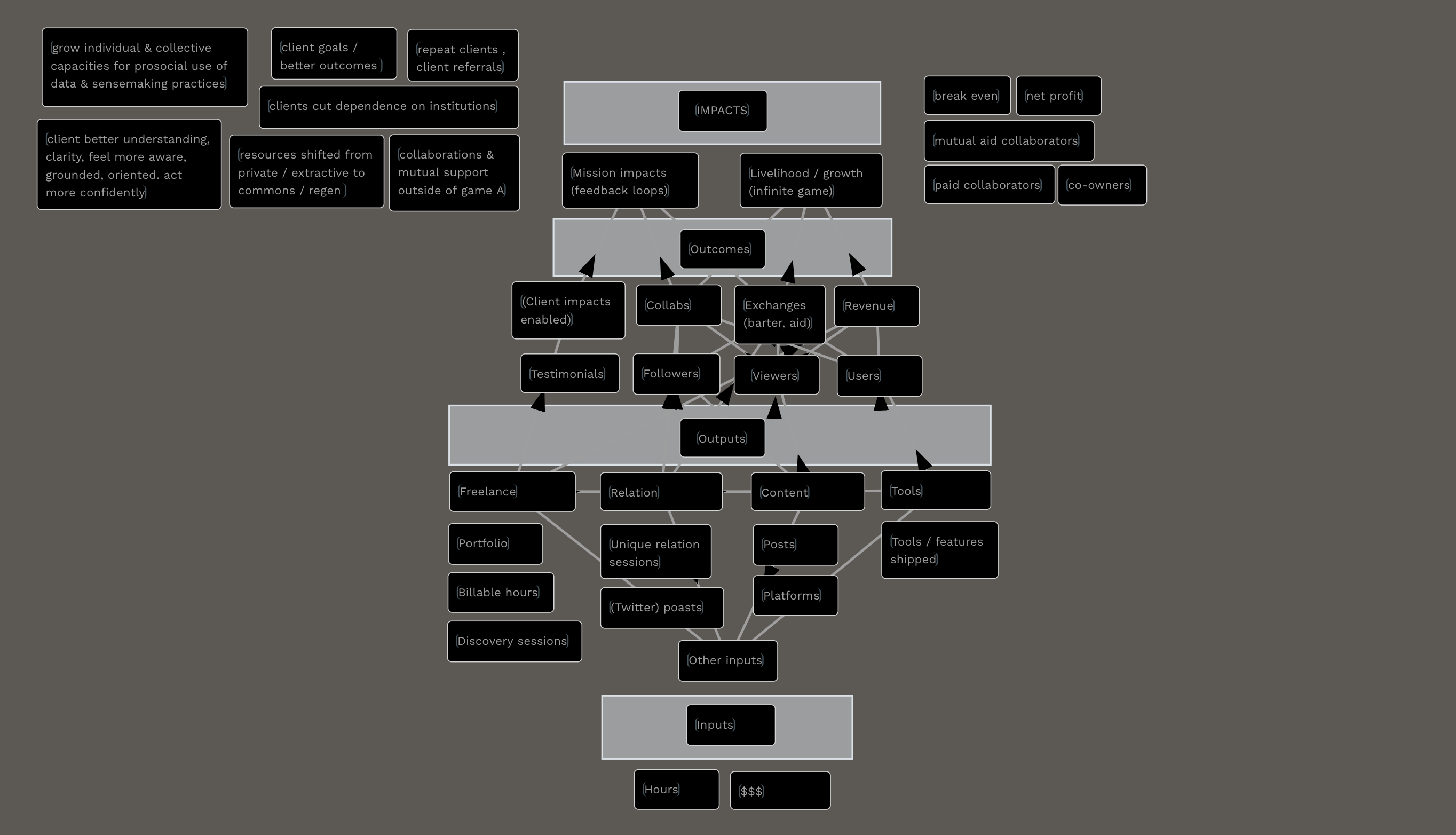 |
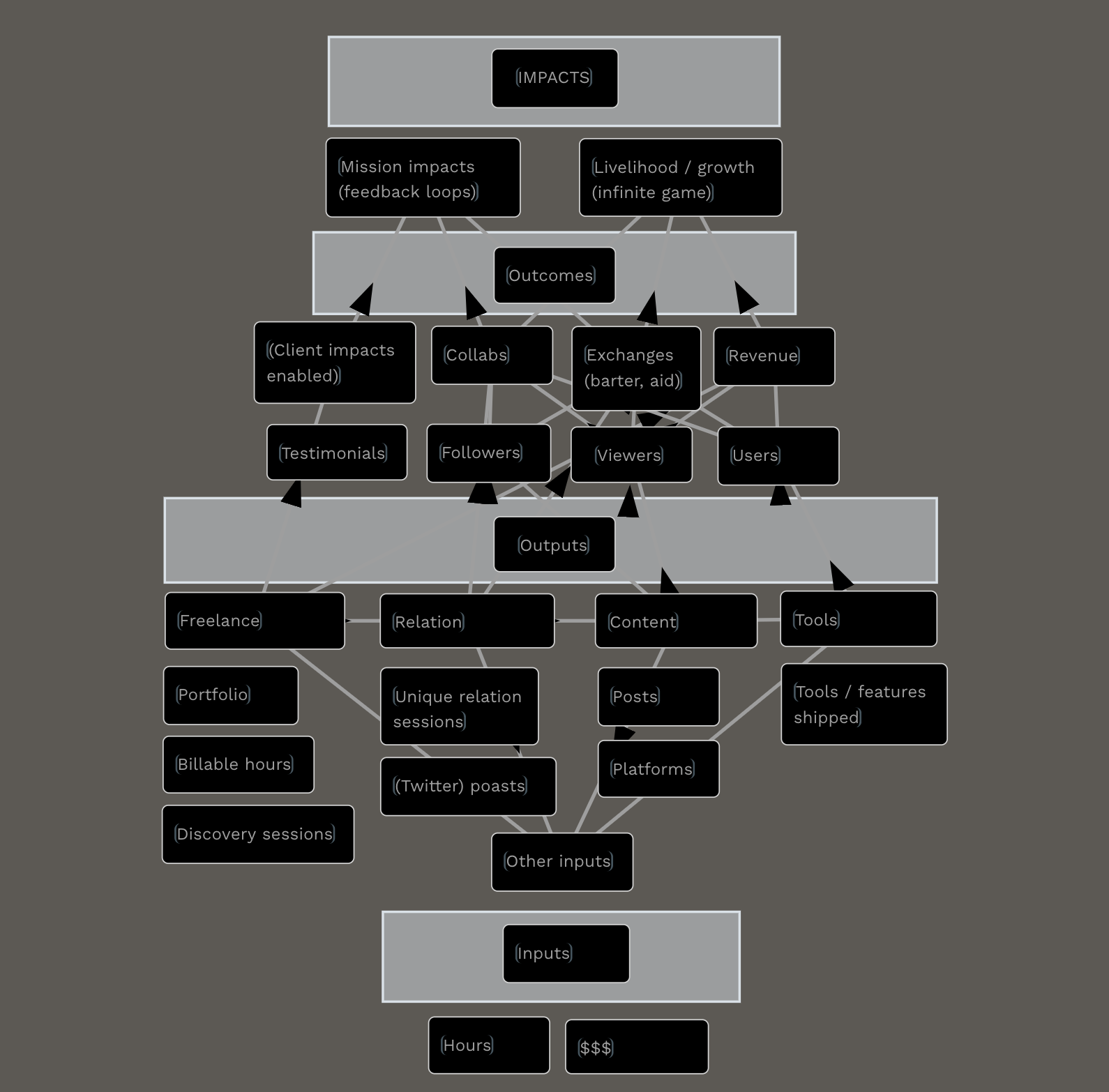 |
Brief notes on the model:
- If not clear, the model should be read bottom-to-top, as the logical flow proceeds from Inputs -> Outputs -> Outcomes -> Impacts
- Our familiar 🏛 Strategic Pillars (types of work) appear here as Outputs, arranged in columns, with the first row essentially serving as column names (Freelance, Relation, Content, Tools) with individual output metrics beneath them, & roughly corresponding Outcome metrics above. See 📊 Metrics / KPIs / Dashboard for more on these.
- The connecting lines & arrows are mostly unreadable in this format (& have no functionality within Roam), so didn't spend much time there
- A strategic focus & overarching thesis of Coεmeta that is so far less explicit in other frameworks, but evident among some Impacts here: an expectation of continued institutional decay, & corresponding need for resilient peer-to-peer support networks outside of institutional contexts. (One modality of this is an increasingly "unbundled" future of work, as feedback loops continue to accelerate Great Resignation dynamics & increased independent worker / gig economy / solopreneurship)
- As with everything, but particularly this early draft, the model will be empirically evaluated & refined as appropriate.
Wardley Maps are probably the most novel & exotic frameworks I used, but also among the most illuminating, & therefore the ones I spent the most time with. These were facilitated & refined over two super productive sessions with Ben Mosior of Hired Thought & LearnWardleyMapping.com (highly recommended!).
I'll defer to Ben, Simon & other experts to explain how to use & interpret Wardley Maps, but in general they are read as value chains of user needs & the capabilities they depend on (top to bottom) along an "evolutionary" x-axis depicting the stage of development for each element of the value chain (left to right). The basic usage is like that of any map: interrogate the landscape & use it to plot a course of action.
We created maps of 4 categories of potential "users" of Coεmeta's work (as clients, collaborators, content consumers, etc):
| Nonprofits & social impact orgs | Small business, startups & solopreneurs |
|---|---|
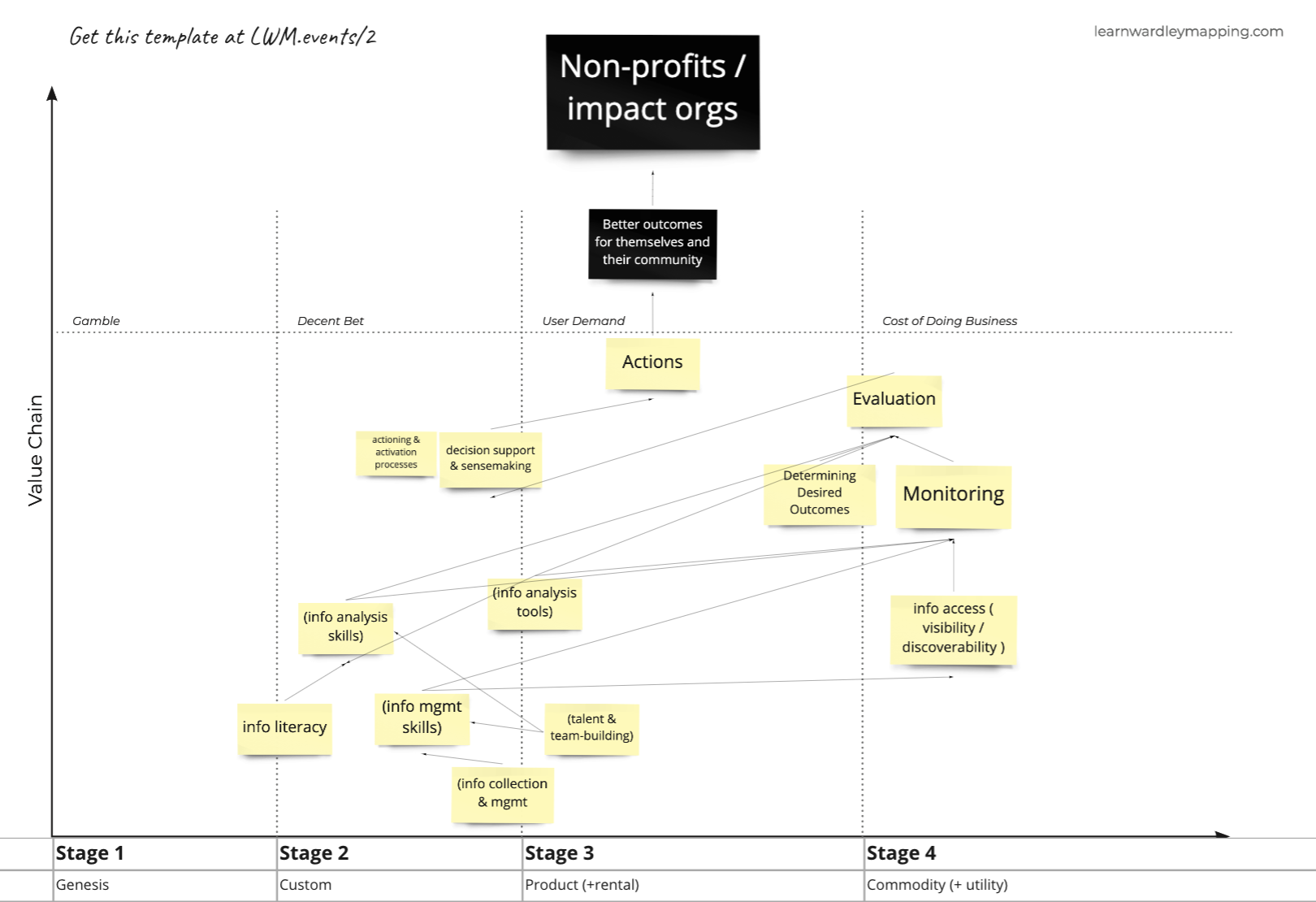 |
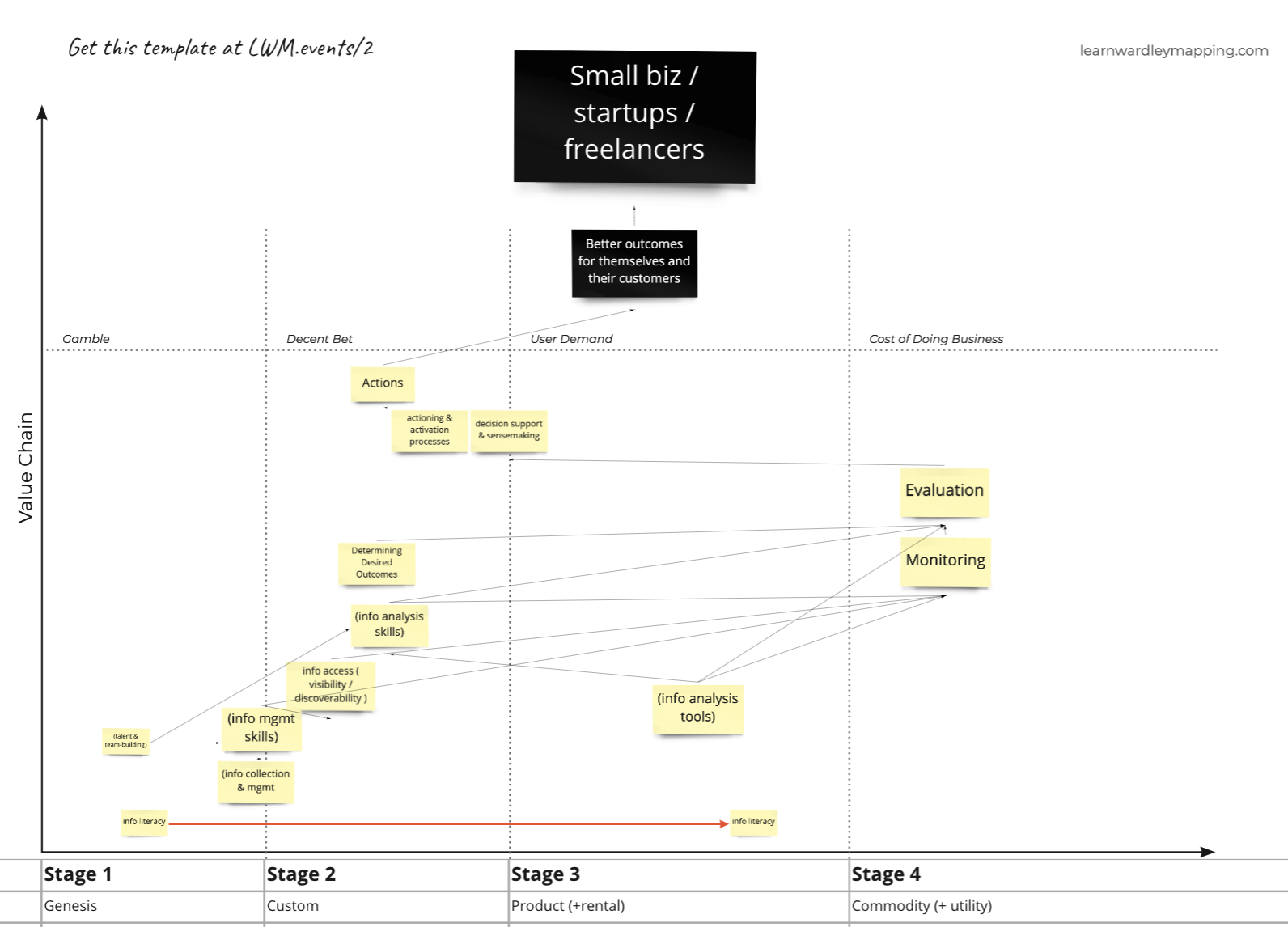 |
| DAOs | Content consumers, learners, mentees |
|---|---|
 |
 |
And then one metamap for me / Coεmeta itself
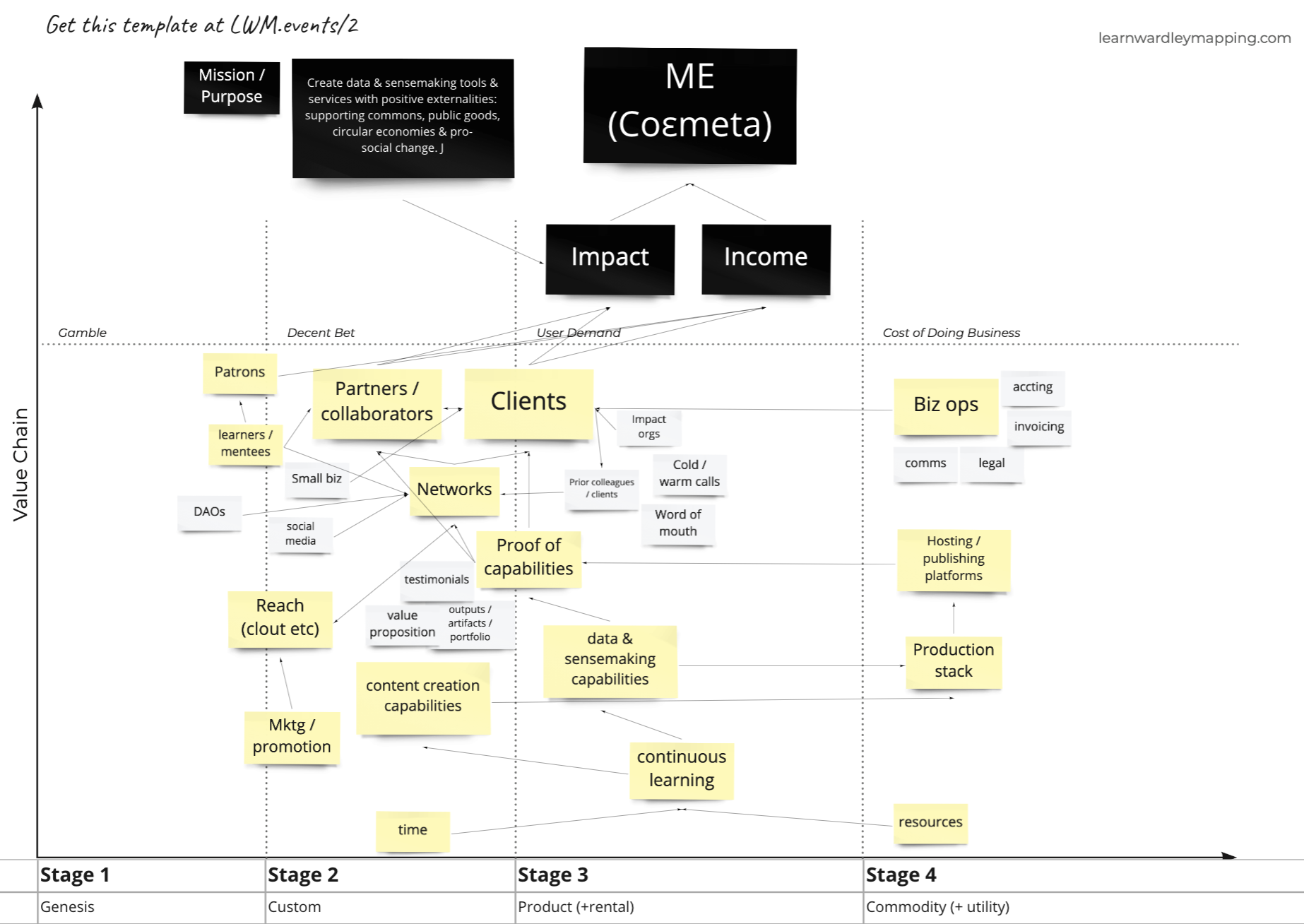
Some general notes & observations:
-
Relative position & general proximity is more important than precise location on the map, so we didn't overthink these initial placements along the evolutionary x-axis.
-
Nonprofit, Small Biz & DAOs all had essentially the same relative positions, but less spread across the x-axis. Some differences:
- Nonprofit / mission-driven orgs think much more about desired outcomes, & generally have info & reporting standards & requirements, so might have more relative maturity & infrastructure in those areas
- DAOs are digital-native & technically advanced, which correlates with data & info maturity
- DAOs (& some nonprofits) have additional(ly salient) needs of collective intelligence & coordination & community-building due to their nature, which present more challenges / opportunities
-
For all:
- Stage 4 areas can be an entry point / low-hanging fruit to demonstrate value if not fully adopting current best practices
- e.g. tool adoption / implementation, automation of manual efforts
- Can then work down (& up) value chains depending on need
- Moving other nodes rightward is generally high-LOE & low-certainty, but can look for quick wins, e.g.:
- applying sensemaking frameworks like logic model / outcome mapping, integrating with evaluation & monitoring systems
- facilitating decision & activation frameworks
- doing underlying work required beyond their current capacities
- training / advising to increase capacities
- Stage 4 areas can be an entry point / low-hanging fruit to demonstrate value if not fully adopting current best practices
- I applied these & other takeaways to refined value propositions, service descriptions & other copy on the initial Coεmeta landing page, as well as my approach with initial clients & potential collaborators. But again, all of this bears experimentation, validation & iteration.
Objectives & Key Results or OKRs are a goal-setting framework native to Silicon Valley & made popular (or notorious) by Google. They've become much maligned & parodied, probably due to being misused, overused & abused.
But ultimately OKRs are about as simple & lightweight a container as imaginable for defining strategic Objectives & assigning a few measurable Results which should represent concrete progress towards the goal. Given this simplicity & flexibility, the devil has lots of room to lurk in the details & implementation.
But I've used OKRs productively both personally & within work teams, eventually developing a custom Google Sheet template tailored to my particular use (open-access & CC BY, feel free to copy & use / adapt!).
Coεmeta OKRS — 2022 Q1:
- Objective 1: Infinite game engine (stabilize P&L)
- Key Result 1: Hit revenue break-even point by end Q1
- Key Result 2: Test & assess 3 revenue strategies / tactics: (Web 3, Patronage, Solopreneur-focus OR Packaged services + outreach)
- Key Result 3: Set money mgmt plan
- Objective 2: Find the others (grow network & relations)
- Key Result 1: Add 50 frens to CRM
- Key Result 2: Build 3 org / group alliances
- Key Result 3: 2 collabs + 6 exchanges
- Objective 3: Serve & grow the game (commons, game~B)
- Key Result 1: 5 Client outcomes / impacts / testimonials
- Key Result 2: Ship 8 poasts & 3 tools
- Key Result 3: Reach 800 ppl across platforms
Snapshot of my OKR summary tab as of 3/20/2022 (link to full sheet):
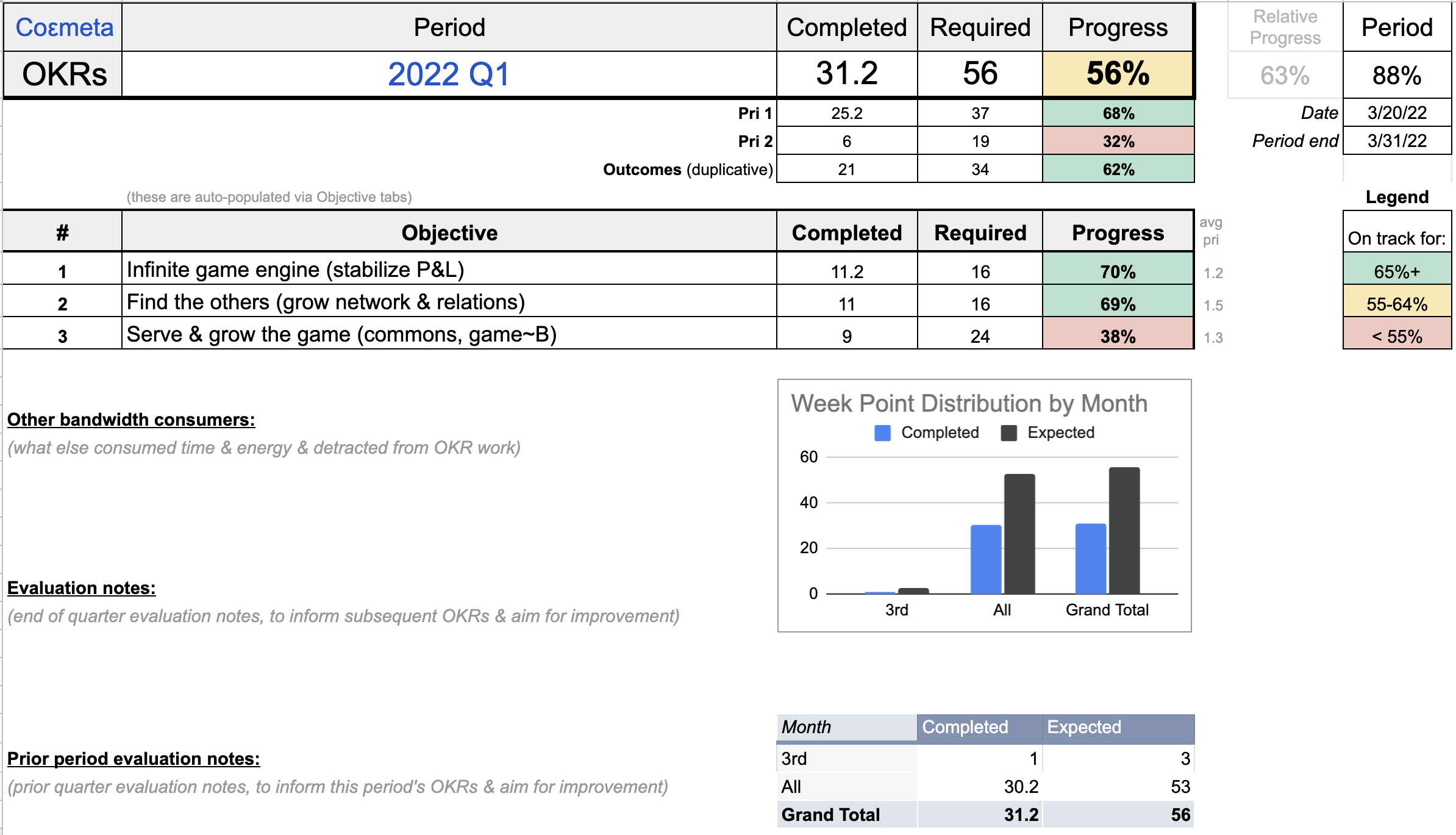
I find 3x3 OKRs (3 Objectives with 3 Key Results each) to be optimally elegant & robust — for aesthetic, numerological & practical reasons.
My OKRs are in decent shape as of this writing, on track for about 63% completion by end of quarter, but I'll probably be able to nudge it a bit higher with a final push through some long-deferred tasks.
(70% is a conventional OKR target, with consistently higher performance indicating too little ambition & stretch goal-setting, but this can obviously be calibrated by context & custom as appropriate.)
I'm a data nerd, so of course I track & monitor a plethora of metrics & KPIs, from my nightly sleep duration to my daily Lichess Elo to detailed time-tracking & performance against Logic Model input, output, outcome & impact metrics depicted above.
I'll clean up & open-source some of these templates & implementations in the future, & will cover them in more detail at that time. But until then, here's a glimpse at some of the ways I currently plan & evaluate these metrics for my own use:
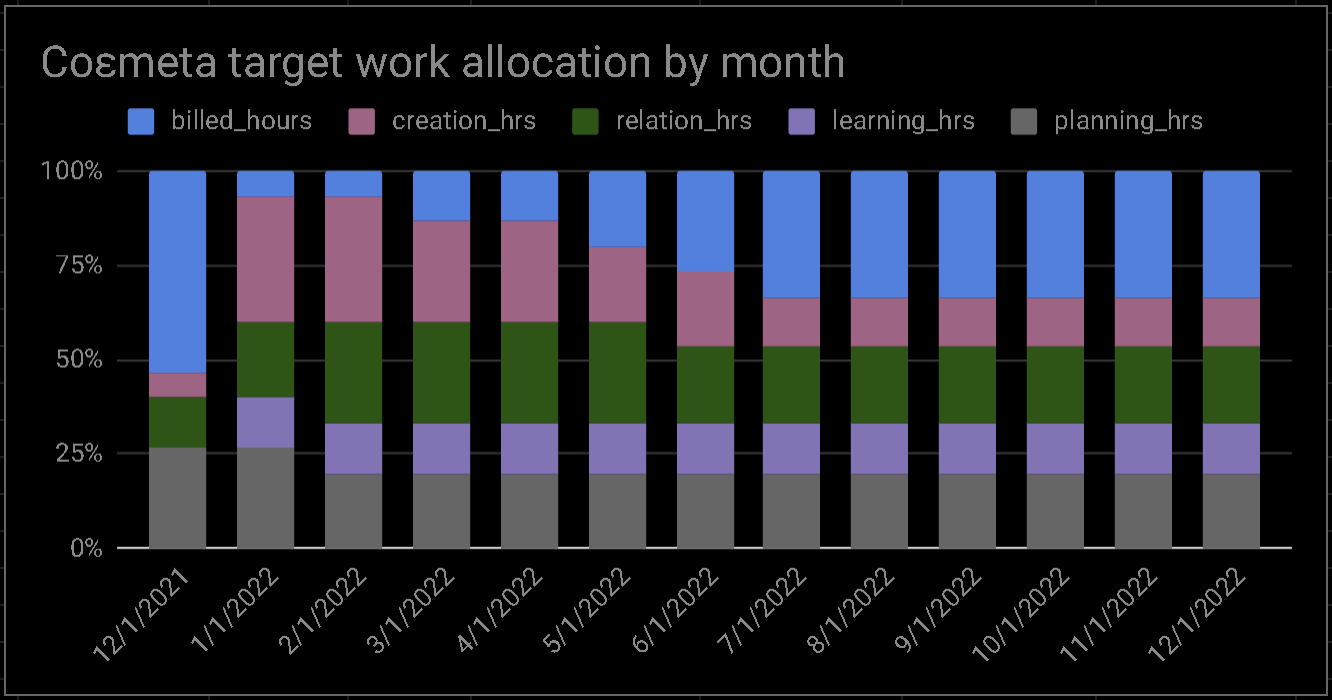 |
 |
 |
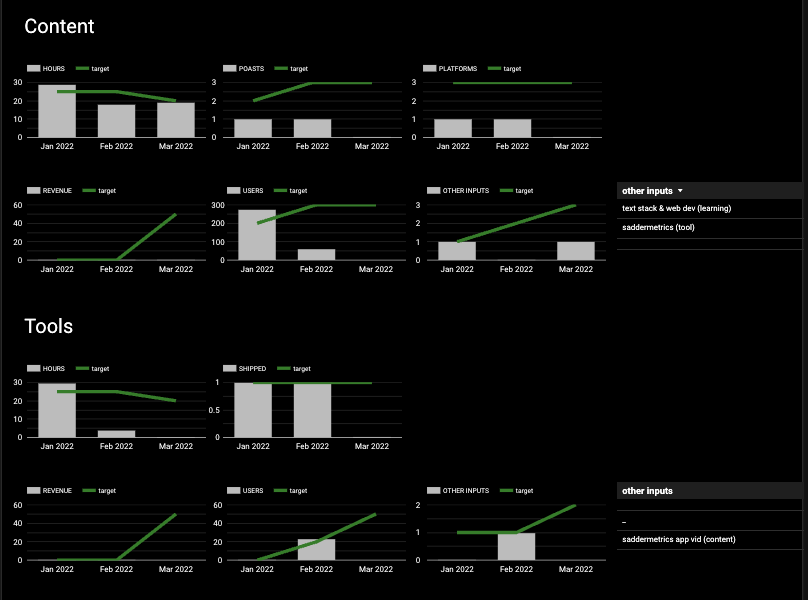 |
I've started to work through an independent learning path offered by Joe Edelman's School For Social Design.
I'm a huge fan of Joe's work & this material, so excited to apply it in the near future!
A brief timeline of relevant events, from Coεmeta's conception, to launch in Jan 2022, to the time of writing on the vernal equinox of Mar 20, 2022. (see subsequent entry timeline here, or the full timeline to-date here)
- 2020-2021:
- Several unsolicited freelance engagements via referrals from peers & former colleagues plant the seed in my mind for a more autonomous & impactful work life: lending my expertise to organizations & individuals lacking the resources for a full scale modern data operation & the empirical optimizations it can unlock, & without the bureaucratic baggage that often squanders those capabilities in traditional mid-large sized orgs.
- Mid-2021:
-
Begin to more seriously conceptualize what a full-time freelance operation of this sort could look like, & the opportunities for a more enriching & impactful life it might unlock.
-
Brainstorm business models, strategies, organizational forms, names, etc. Increasingly excited by the vision taking shape, & increasingly motivated by ...reasons.
- See the Frameworks section of this post for details related to strategy & business models
- Eventually settled on the compound neologism / portmanteau Coεmeta as a working name
- The conceptual composition of this coinage is conveyed in the janky DIY banner logo I scrawled in excalidraw:

- To elaborate: the overarching concept is co-creation of knowledge & understanding, aka "collective intelligence & sensemaking", or as stated in our mission & vision: finding truth together.
- The core substring emet (hebrew for "truth") is borrowed from golem folklore, as inspired by Richard McElreath's admonitions about statistical models as "golems" or "robots" in his Statistical Rethinking course & textbook.
- In that folklore, golems are clay monsters brought to life by inscribing "emet" (truth) on their forehead, & then 'decommissioned' by scratching out the initial character, to leave "met", meaning "death".
- I played on this (a bit melodramatically, admittedly), by using an "ε" for the first "e", as described above:
-
In fact the epsilon ("ε") in Coεmeta is meant as a reminder of the 'error margin' in any model, estimate or probabilistic assessment, as further described in the etymology outlined in the timeline section below.
-
- Beyond that, the "co" (together) & "meta" (big picture) substrings should be pretty self-explanatory
- Finally, the resulting composite Coεmeta has resonances with a few other somewhat obscure terms which are personally meaningful to me:
- Gallia Comata - literally "long-haired Gauls" or "free Gaul", referring to lands & peoples not yet conquered & colonized by Romans
- Coimimeadh [koym-imah] - Scots Gaelic word referring to "co-walker" or "co-traveller" spirits
- The conceptual composition of this coinage is conveyed in the janky DIY banner logo I scrawled in excalidraw:
-
-
- Research legal steps & paperwork for business formation, have several consultations with an amazingly helpful SBDC advisor, a values-aligned law firm (Jason Wiener | p.c.) & Ben Mosior for our first super productive Wardley Mapping deep dive session. (Also reach out to the local SCORE chapter, but it's about a month before they can match me with a mentor.)
- Oct 2021:
- Mind made up, give notice to my current employer, arrange to stay on part-time through the rest of the year to assist with turnover & onboarding etc, while I ramp up my new business.
- Begin drafting business formation docs & using downtime to plan & prep for a launch in the new year (& also decompress).
- Meet with Opolis membership steward to explore joining their "employment commons", a worker cooperative for independent workers which provides some of the benefits typically reserved for W-2 employees. A novel model deeply aligned with my own values & vision of a non-institutional, more peer-to-peer future of work. Also deeply involved with emerging web3 models & values, which I intend to further explore.
- Matched with SCORE mentor in late-October, schedule initial session. Mentor is a local former executive & current nonprofit board member, an extremely helpful sounding board & wealth of experience to help guide my early efforts.
- Obligatory personal news tweet
- Nov 2021:
- Submit business formation docs for a PA Public Benefit LLC on Nov 3, with comprehensive assistance from SBDC advisor (saving 100s if not 1000s of dollars in lawyer fees). Estimated 2 weeks for approval.
- Connected with gun violence reporting nonprofit newsroom The Trace re: data work for their local Philadelphia Up the Block project, agree to help however I can on a pro bono basis since my business is still not officially formed & they're doing vital work in the community, exactly the sort of thing I'm trying to free myself up to work on.
- 2nd Wardley Mapping + freelance strategy session with Ben Mosior, once again super helpful & generative
- Further admin tasks, buy Coεmeta domain names, set up email & social accounts, etc
- Dec 2021:
- Still no word from PA Dept of State on LLC formation approval, after many followups & hours of sitting on-hold like it's the 20th century dark ages, turns out my submission was rejected for not adhering to mysterious requirements which were not communicated on any form or instructions etc (related to the relatively rare Public Benefit designation), so had to resubmit & go to the back of the queue for approval, which now takes an estimated 4 weeks instead of 2, due to staff shortages & increased demand. Will I actually have a business by Jan 1 when my current part-time work agreement ends?? Stay tuned!
- Pre-onboarding followup session with Opolis membership steward, explain business formation limbo, discuss potential paths forward, decide to wait out PA State Moloch & consult with tax accountant on different approaches
- Continue with pre-launch business admin tasks: drafting minimum viable landing page, receive kind testimonials from past clients & colleagues, have additional productive & reassuring sessions with SCORE mentor
- Begin executing content, toolmaking, & relation-first strategy:
- Increase activity on social networks, as well as peer-to-peer & small group engagement
- Draft & test content ideas in twitter threads like this one
- Fork & extend a rate demo widget on Code Pen as open source toolmaking practice (& to use on my landing page)
- (Holidays etc)
- Business approved on Dec 28, we made it 🥲
- Jan 2022:
- (Soft)launch posts on twitter 🥳 & linkedin 🤢 & outreach to a few personal networks
- Some immediate interest & referrals, discovery sessions with potential clients & collaborators
- Continue content, toolmaking & relation strategy:
- Publish Ingroup Colossus post based on initial twitter threads, got some engagement, particularly on twitter & largely thanks to a share from Colossus himself: @visakanv
- Begin developing # SADDERmetrics R code & shiny web app based on initial ideas in this twitter thread
- Begin client work based on initial discovery sessions, including with City Bureau, an amazing nonprofit org from Chicago with values & vision deeply aligned with Coεmeta's, building capacity for participatory community-journalism as a public good.
- Begin mentorship 1:1 sessions with two mentees
- Decide to join Opolis as a coalition member at this point, with intent to join as a full employee member-owner once I establish reliable cashflow (required for automated payroll services), so to not add more budgetary pressure than necessary up front
- Feb 2022:
- Continue work across the pillars:
- Client work demand beyond my initial expectations shifts initial time allocation plans, but happy & appreciative to do it!
- Ship # SADDERmetrics web app to decent engagement, continue iterating & refining
- Record & ship full # SADDERmetrics walkthru video after assembling a minimal recording & editing tech stack & setup
- Continue building relationships, potential partnerships & collaborations online & offline
- Persistent migraines & a week-long (non-covid) illness diminish my capacity & progress somewhat, but happy to have the flexibility to rest & recuperate as needed
- Looming war drums & Russian invasion of Ukraine consumes some additional attention & emotional energy, given the remote but non-zero chance of escalation to world-scale or nuclear conflict, not to mention the (unfortunately less rarefied) horrific human-level tragedy of it all
- Continue work across the pillars:
- Mar 2022:
- Continue primary focus on client work & relationship-building, though finding less time & energy for public work & engagement, but resolve to regain balance
- Begin to put out formal calls for microsolidarty-style small groups for mutual support & community-building, as already discussed in other peer-to-peer & small group contexts
- Draft & publish this Public Work Log entry for the 3/20 vernal equinox
- (see subsequent entry timeline here, or the full timeline to-date here)
I'll leave the raw scorekeeping & evaluation metrics for another update, along with a formal open-source strategy repository for proper versions of some frameworks & other artifacts covered above. I wanna keep this post more narrative-based & vibey.
So speaking of vibe checks: I feel good.
I've found some of the greater balance I was seeking, in several areas:
- lifestyle (sleep, diet, activity, etc)
- inner & outer life (no longer perpetually socially exhausted by relentless compulsory sociality, I'm more open to voluntary sociality)
- work-life balance (& crucially, integration of some aspects of these, while maintaining healthy boundaries with greater autonomy)
And my more integrated work-life has been more rewarding, & more palpably impactful (though limited in scale & scope so far).
It's extremely early in the game, & there have been challenges, setbacks, looming doubts & uncertainty, etc. I did a lot of planning & yet, predictably, things did not go exactly according to plan. But overall things are good & the path feels right. I look forward to continuing to shift to more of an outward focus, enabling clients & collaborators to be more impactful, & growing our mutual capacities together.
The Coεmeta journey so far has been, frankly, smoother & more successful than I probably had any right to expect. And that is largely due to luck, & the kindness of others — e.g. peers & former colleagues generously making referrals & enthusiastic endorsements (or retweets) — more than anything I've done myself. As described above, I did a lot of planning & strategic sensemaking, put in the time & effort etc, but the most positive developments have all been precipitated by others, or lucky breaks.
I don't expect this to continue indefinitely. There will be greater challenges, feasts & famines. Maybe there will be times when my big-brain planning frameworks produce the crucial insight or tactical adjustment which enables a great breakthrough. Maybe sheer determination & individual effort will carry the day. But I hope not. I'd rather continue to be primarily powered by the support of others, & return the favor, pay it forward & work synergistically whenever possible. And in the meantime I'll continue wayfinding towards greater balance, integration & impact, by myself & with others.
That is the metagame, the infinite game:
a more balanced, integrated, enriching & impactful life in greater community
...& for now at least, with zeal & gratitude, I'm still playing 🙏🏼

